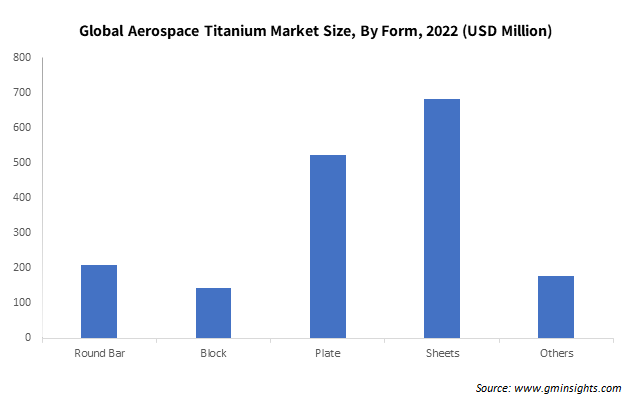Home > Aerospace & Defense > Aerospace Materials > Metals and Composites > Aerospace Titanium Market
Aerospace Titanium Market Analysis
- Report ID: GMI2080
- Published Date: Feb 2023
- Report Format: PDF
Aerospace Titanium Market Analysis
The sheet form segment is poised to depict gains at nearly 5.5% through 2032. Favorable product attributes including lightweight, high strength, biocompatibility, corrosion resistance, and high-temperature performance are among the key drivers propelling industry growth. Additionally, metal manufacturing firms, including Nippon Steel Corporation, are manufacturing commercially pure titanium sheets for aircraft applications. These sheets have excellent cold formability compared to other sheets, thereby resulting in their increased usage in aircraft manufacturing.
Aerospace titanium market value from additive manufacturing method will surpass USD 250 million by 2032. Metal hybrid additive manufacturing machines are well suited for the aerospace sector, considering the requirement for lightweight aircraft parts with complex geometries. In recent years, additive manufacturing technology has gained massive momentum as a suitable alternative to traditional printers, owing to the ability to create stronger and lighter parts. With 3D printing, no extra costs are needed for adding complexity to improve rocket performance, making it the preferred manufacturing method to address the burgeoning aerospace titanium demand.

The 6AL-4V grade segment will exhibit a 5% CAGR between 2023 and 2032. High-temperature strength, ductility, fracture toughness, weldability, heat treatability, machinability, and other key properties will amplify the sales of 6AL-4V grade titanium. Fund generation for next-generation aircraft development has also increased. The U.S. Congress proposed funding worth USD 7 billion to enable the U.S. DOE to procure new aircraft in 2023 under the USD 1.7 trillion spending bill. The requirement for turbine engines and airframes for fighter aircraft will therefore surge, further increasing 6AL-4V grade titanium usage.
Aerospace titanium market revenue from the commercial aircraft end-user segment exceed USD 1.5 billion by 2032, given the rise in tourism. As per data from the Saudi Central Bank, in 2021, overall tourism spending, including foreigners and residents, showed a 52% increase from 2020 in Saudi Arabia. This rise in tourism spending is likely to boost travel passenger traffic and encourage commercial aircraft manufacturers to increase their fleets. These factors will consequently spur the use of aerospace titanium alloy in the production of landing gear and other aircraft components.
Asia Pacific aerospace titanium market is set to reach USD 400 million by 2032, owing to the growing population and the air travel recovery in the region. According to the International Air Transport Association, in November 2021, air traffic surged by 41.3% compared to 2021 levels, with the APAC region reporting the strongest Y-o-Y results. Furthermore, the rising disposable incomes and the escalating investment in space technologies will strengthen the regional market outlook.

